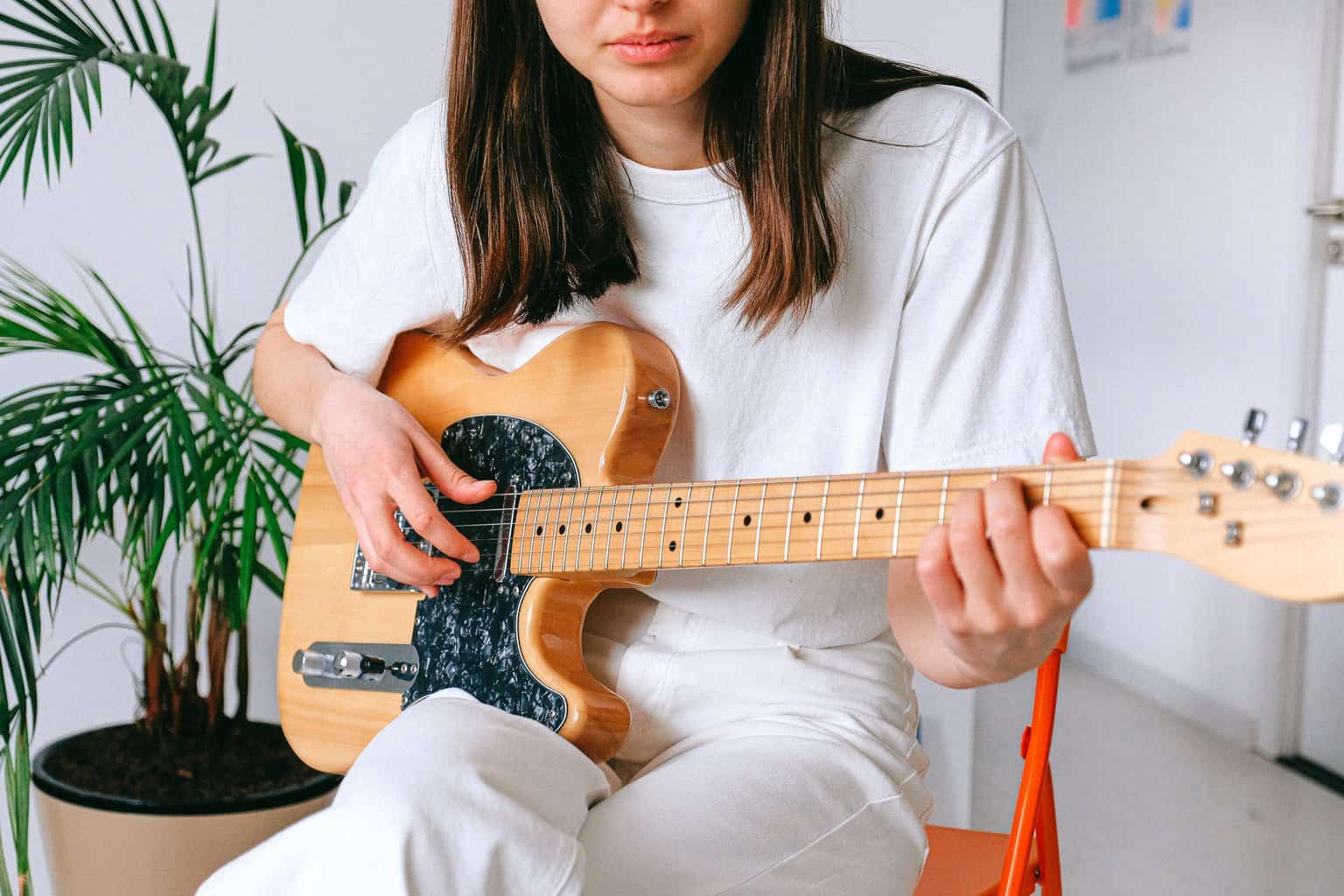When picking or building a new guitar the fretboard should be one of your main concerns.
Your fingertips will be actually touching this part of the guitar all of the time. I know this is not news to you, but it’s important to just state it to remark its importance.
But how does the fingerboard material of a guitar affect its tone? Here is a short answer:
The fingerboard of a guitar has a great impact on both tone and feel. Different tonewoods will result in different tonal experiences. Its physical characteristics will subtract in varying ways from the string’s fundamental tone. The neck and fretboard could define up to 70% of a guitar’s tone.
For those who want a deeper dive into the effects of fingerboard tonewoods in the guitar equation, in this article, I will talk about the most popular materials for this part.
After that, I will answer some of the most common questions about guitar fretboards and their effects on feel and tone.
Finally, I will give you my recommendations and conclusions about this topic.
Are you ready to get started?
Let’s go!
Does fretboard material affect tone?
Fingerboard material has really a significant impact on the tone and feel of a guitar. I adhere to Paul Reed Smith’s idea on tone. By keeping it simple, Paul says that a tensioned string has a particular tone and that when it comes in contact with other materials these carve out some frequencies from that fundamental tone.
This idea of subtractive timbre makes real sense for a guitar. Think of it as if you were filtering frequencies with an EQ when picking different tonewoods. If you could replace the fingerboard of a guitar with an identically shaped one from another material you will probably hear a difference in tone.
Of course, in some cases, there will be greater variability within 2 trees of the same species of wood than among 2 different varieties. You see, trees are heterogeneous living beings and you won’t find 2 identical ones.
It also goes without saying that not only the neck and fingerboard of a guitar have influence in tone but the combination of all of its components, as I said earlier.
Also, and to conclude this section, keep in mind that feel is also a very important factor when deciding upon a new instrument, and the fingerboard will be the home of your playing hand. Make sure you get a nice comfortable one.
How much does fretboard material affect tone?
Quantifying how much does the neck material of a guitar affects its tone is not easy and it would require a very professional scientific approach. I can’t offer you that. All I’m about to say is based on empiric and anecdotal evidence.
Leaving that out of the way, many players claim that the neck and body of a guitar have a 60% – 40% or even 70% – 30% relationship in terms of the effect on the final tone.
The bigger share the neck claims is explained by its smaller mass (10 to 12 times smaller) and by its more extensive contact with the strings and support of their vibrations.
As you could infer, this leaves for a rather big impact to be had for the fretboard in terms of tone. The material of a guitar’s fingerboard will undoubtedly define the personality of the tone the neck has to offer.
Most common fingerboard materials and their effect on tone
Guitar fingerboards are made of multiple materials and all manufacturers have different motivations for their choice. From aesthetics to feel to tone to economics, and also the interactions of the fingerboard with every one of the other components of the instrument.
Here I will focus on tone.
These are the most common fretboard materials in guitars and their effects on tone:
Maple

Maple is a light-colored hardwood very common in the USA and Canada. Professional bowling pins are made of this wood. For guitars, it’s usually used in necks and tops.
In terms of tone, Maple enhances upper-mids and high frequencies particularly, however, it also produces a tight, well-defined low end.

Roasted Maple

Roasted Maple, as its name implies is just thermally treated regular Maple. Exposure to high temperatures makes the wood more stable (less prone to bend due to weather changes) and changes its appearance and feel. This process also has the effect of making the material more brittle and harder to work with.
In terms of tone, Roasted Maple retains the same character as normal maple. It is still the same wood. Some people, however, argue that due to its extra brittleness it has an extra chime in the top end.

Rosewood

Rosewood is a durable dark-colored tonewood popularized by the use of its Brazilian variety used in vintage instruments, since regulations restricted its availability it was replaced, by most manufacturers, for the Indian variety.
In terms of tone, Rosewood is a very warm-sounding material known to cut off harsh high frequencies and making an instrument’s tone “rounder”.

Indian Rosewood

Indian Rosewood is the most common variety of this wood type nowadays since the South American alternative has been heavily restricted for years.
In terms of looks, Indian Rosewood tends to have a purple hue and a harsh grain.
In terms of tone, what’s said for Rosewood overall still stands, this is a hard tonewood that has great bass and mid response and starts cutting off highs and unflattering frequencies in that range.
Brazilian Rosewood
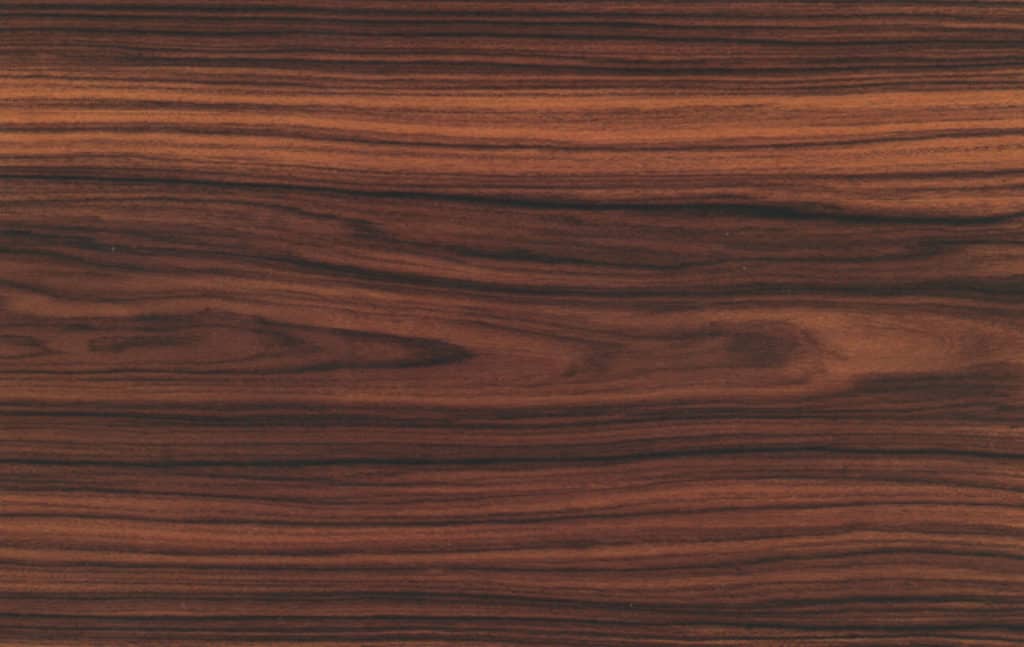
Brazilian Rosewood was made popular in the late ’50s and early ’60s since it was the variety legendary builders such as Gibson and Fender used for their currently most sought-after instruments.
The Brazilian variety has a deep chocolate brown color with a well-defined grain and that provides it some luxurious looks.
In terms of tone, some argue that this is a harder version of Rosewood and it could result in slightly better bass response and more sustain. However, this extra hardness can also mean less stability and it being more difficult to work with.
Ebony

Ebony is the king of luxurious hardwoods. It’s maybe one of the darkest-looking tonewoods. It’s oily and some might consider it a mix between Maple and Rosewood. This material is native to Africa and Asia and has been for years a very demanded ornamental wood.
In terms of tone, Ebony is well-known for its tight lows and sharp top end with balanced mids. As with every other hardwood, and with being one of the hardest its sustain is remarkable.

Indian Laurel

Indian Laurel is a hardwood native to Asia. It has a chocolaty dark look with a defined grain and it’s commonly used in furniture and cabinetry as well as an alternative to Rosewood, and particularly Indian Rosewood.
In terms of tone, Indian Laurel is what you would expect from a hardwood. It has a great low-end response, it is rich in mids, but unlike Rosewood it doesn’t cut off the high-end as elegantly. However, this defined top-end personality is a reason to choose it

Granadillo

Granadillo is a hardwood native to Central America. Its look varies from bright red to a darker hue or purplish brown. Its defined straight patterns and its hardness make it another great alternative to Rosewood for guitars.
In terms of tone, Granadillo keeps up with the rest of the hardwoods providing nice lows and balanced mids. In terms of top-end, it’s a bit brighter than Rosewood and some trained ears claim that it has a distinctive chime in the upper part of the frequency spectrum.
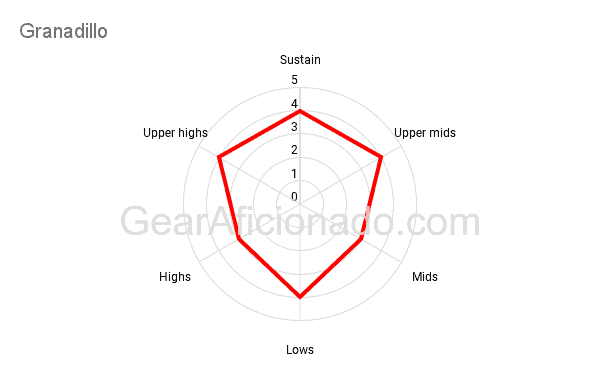
Pau Ferro
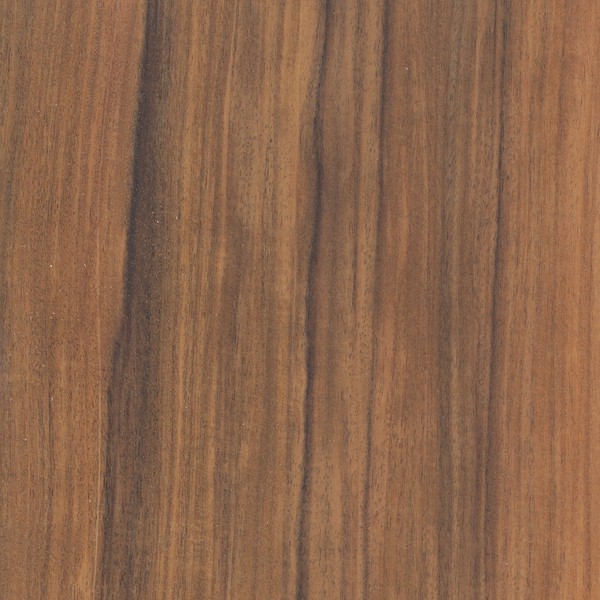
Pau Ferro is a South American tonewood, referred by some as “Bolivian rosewood”. It is slightly lighter in hue than traditional rosewood, but pretty similar in other aspects. However, these 2 species are not related.
In terms of tone, Pau Ferro, as you would expect, offers a pretty similar frequency response as rosewood with great low end, mids, and amazing sustain. The slight difference is that you could get a bit snappier high end with Pau Ferro.

Ovangkol

Ovangkol is an African hardwood. It has a yellowish to brown hue with a very defined straight grain. As with every other hardwood, it is commonly benchmarked with Rosewood and used as an alternative.
In terms of tone, Ovangkol offers the same features as many other hardwoods: Great low end. In particular, this tonewood is known to produce a warm midrange and a rather bright top end compared to Rosewood.

Walnut

Walnut is a less common hardwood in mass-produced instruments, it is comparable to maple in terms of hardness and density, and it has an oily soft brown surface.
In terms of tone, Walnut offers a bright top end with a pronounced midrange and a deep low end. It also has a nice impact on sustain.

Richlite / Richlight / Rocklite

Richlite, Richlight, and Rocklite are not exactly tonewoods but manufactured materials made of compressed paper resin. They are marketed as a more sustainable alternative to hardwoods, and they are also cheaper.
In terms of tone, Richlite, Richlight, and Rocklite are quite balanced alternatives to most hardwoods and they don’t imprint a particular personality on the instrument.

Micarta

Micarta is a composite material made from fabric and resin. It is produced in many different ways and it’s very commonly used to make knife handles. It’s hard, durable and some guitar manufacturers choose it as an alternative to hardwoods.
In terms of tone, Micarta can be put in the same space as other wood alternatives. It offers a balanced frequency response and it doesn’t add any particular personality to the instrument. Its neutrality helps the other woods shine on their own.
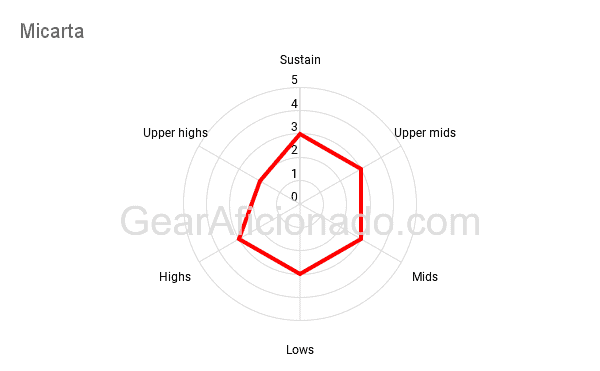
Stainless Steel

Stainless Steel is a metal alloy known for its durability. The common theme in fingerboards is hardness and you can’t probably go harder than metal. This material is not as usual, but it has been seen in some guitar necks through the years.
In terms of tone, Stainless Steel will provide very present lows but also a very sharp top end. This one might not be for everyone.

Roseacer
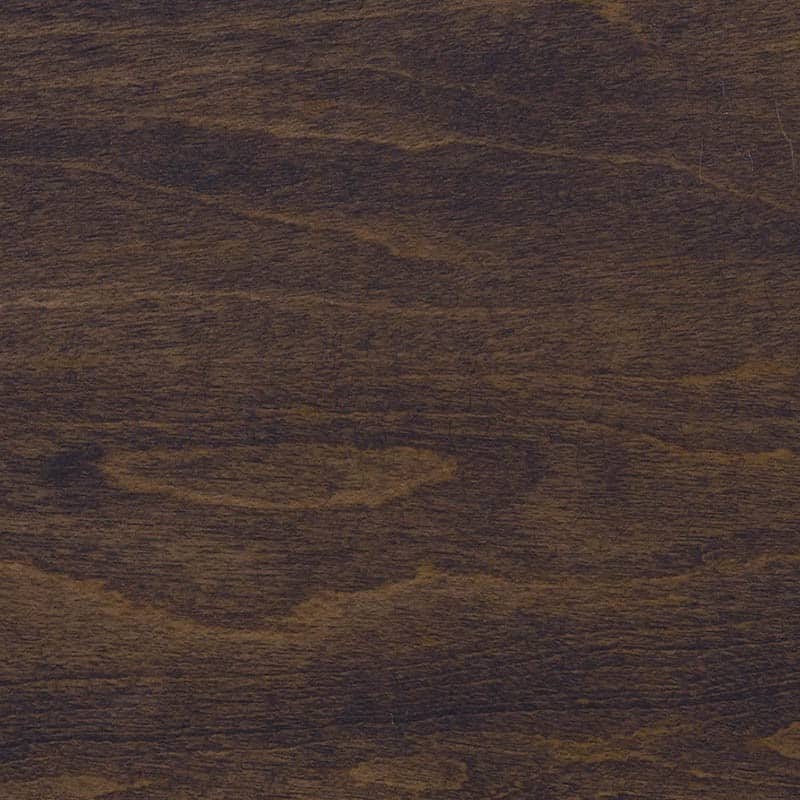
Roseacer is just another name for Roasted Maple. However, in my experience, I have found manufacturers describing the material with this name mostly in entry-level instruments. For this reason, I will consider Roseacer as lower quality (or cheaper) Roasted Maple.
In terms of tone, Roseacer will be almost the same as Roasted Maple, however, by considering it being of lower quality, It will probably retain more humidity making it softer and thus making the low-end response and sustain a bit weaker.

Jatoba

Jatoba is a hardwood native to South America, and particularly common in Brazil. It is low cost and looks like a distant, clearer cousin of rosewood, however, they are not related. In fact, this tonewood isn’t quite as oily and it will require some extra care.
In terms of tone, Jatoba has nice lows like every other hardwood, a warm midrange, and a rather bright and clear top end.
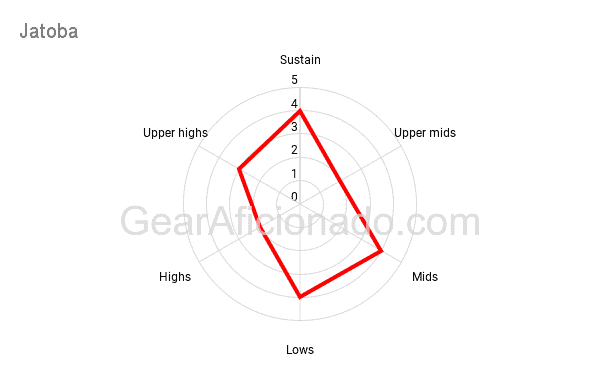
Fretboard feel is probably more important than tone
The rise of artificial, or materials other than wood, in fingerboards of rather nice guitars, has left many players thinking about the overall importance of this component.
In my opinion, there’s nothing as the real deal. However, the stability and easiness to work with alternative materials such as Richlite or Micarta have to offer are really compelling.
In terms of tone, many players claim that they don’t feel any difference or hindrance from instruments that incorporate these modern options.
In terms of feel, synthetic materials don’t offer as much resistance to the touch as Ebony, for instance, but this is not necessarily a bad thing. Some people might prefer it that way.
Overall if it feels and sounds right to you. Go for it.
What is the best fingerboard material?
There is no such thing as the best fingerboard material for a guitar. Different kinds of wood offer different properties that different kinds of players will love or hate.
Some will prefer the tone of Rosewood over the feel of Maple, and others will go for the opposite.
It’s of the essence that you get to try out as many different guitars made from different materials as you can so you could arrive at your own conclusions and define your particular preferences.
Every piece of wood has its own soul inside and some might not resonate with you, but when you find the right one, you will know.
That last sentence could also work as dating advice.
Why are some fingerboard materials not used anymore?
Back in 2017 CITES, a governing environmental body born from a global agreement across country authorities banned the use of some kinds of woods to protect flora and fauna.
These woods, such as Rosewood, were commonly used to make furniture, but also guitars.
The ban extended to the following tonewoods:
- All rosewood varieties
- Granadillo
- African Blackwood
- Cocobolo
- Kingwood
- Bubinga
- Any other member of the Dalbergia family of woods
Fortunately, in late 2019 the embargo was lifted and now manufacturers can resume their use of these materials.
However, Brazilian Rosewood is still listed and fully restricted.
Do scalloped frets sound different?
Guitars with scalloped frets will sound different since their fingerboards have less mass overall. This doesn’t mean that they will sound better, worse, or even that the difference will be really noticeable.
Keep in mind that feel and playability might be a greater motivation for those who choose to get a guitar with scalloped frets, and that’s great.
Conclusion and recommendations
Whether you are looking for a new guitar or planning on building or having one built, getting to know, at least at a high level how tonewoods work is, in my opinion, something that will help you make a better informed final decision.
However, here in GearAficionado, I always say that you should try out every instrument before buying it if you have the chance.
I don’t think anyone can really understand the sound of all these different tonewoods without getting to hear them live. At least try the ones that you think might work out better for you.
If it’s within your reach, try to get to play completely different guitars to clearly understand where the variation lies, and then start checking out ones closer to the one you preferred the most.
Finally, don’t forget to have fun. Technicalities for some people get the joy out of getting a new piece of gear. You don’t have to know it all about something that makes you smile. Just go and play the instrument that feels best to you.

Hello there, my name is Ramiro and I’ve been playing guitar for almost 20 years. I’m obsessed with everything gear-related and I thought it might be worth sharing it. From guitars, pedals, amps, and synths to studio gear and production tips, I hope you find what I post here useful, and I’ll try my best to keep it entertaining also.

